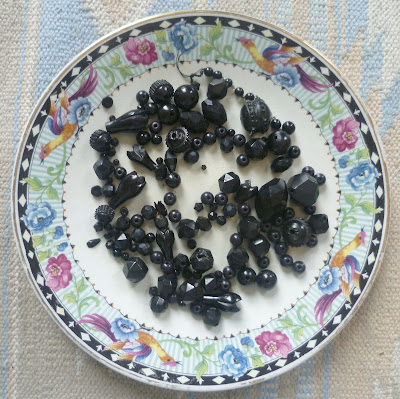Considering how many of Jane Austen’s heroes and heroines
have lost a parent, there is remarkably little about mourning in her novels.
The only characters who are directly affected by losing a parent are the
Dashwoods in
Sense and Sensibility.
Elinor and Marianne’s father dies in February and Mrs Dashwood and her
daughters remain at Norland Park for at least six months before they move to
Barton Cottage in Devonshire. There are several reasons why Jane Austen allowed
so long a time to elapse; first, it overs the first six months of secluded, deep
mourning expected for a husband or parent, and, more practically from a
novelist’s point of view, it gives Elinor time to get to know the attractive
but diffident Edward Ferrars, brother of her mean spirited sister-in-law, Mrs
John Dashwood, the new chatelaine of their home, Norland Park.
19th century mourning jet choker
However, once they are settled in Devonshire, they visit Mrs
Dashwood’s cousin, Sir John Middleton, at Barton Park and enjoy a lively social
life. Marianne meets the handsome and eligible Willoughby, and falls in love.
The fact of them being now in half-mourning isn’t mentioned. And the following
January, Elinor and Marianne accompany Mrs Jennings to London to enjoy what
society has to offer without worrying about the propriety of it whilst they are
in mourning. Possibly, the custom of lengthy mourning for relations was not yet
so strictly observed in Society as it was to be later on;
Sense and Sensibility was an early novel, first written in 1797-8.
Mourning brooch with the deceased's plaited hair under the glass
The mourning is much more overt in Persuasion. When Anne Elliot first sees her cousin Mr William
Elliot in Lyme, both he and his manservant are in mourning for Mr Eliot’s wife
who died six months earlier. Jane Austen uses Mr Elliot’s mourning to help Anne
learn about his true character from her friend Mrs Smith who once knew him
well. Even if he didn’t care for his wife, surely he should be affected by her
sudden death only six months before. He certainly ought not to be making up to
the mercenary Mrs Clay who, Anne suspects, has plans to become the second Lady
Elliot. Is Mr Elliot exercising his wiles to forestall that happening?
Ebony fan
So what were the correct periods of mourning during the 19th
century? Views became more extreme as the century wore on. At its height, a
widow was expected to be in deep mourning for a year, wearing clothes made in matt
black paramatta (a sort of silk/wool bombazine) and crepe. Twenty-one months
later, she might leave off the crepe and three months after that she went into
half-mourning for six months: grey, lavender, mauve, violet or grey and white
stripes. As The Queen magazine put
it: she was the victim of ‘a mild form of
suttee’.
Cameo in jet frame
The mourning for a parent or child was a year. Again, one
gradually ‘slighted’ the mourning. It must have been a relief to be able to
wear jet ornaments, and, a little later, pearls, gold and silver and diamonds.
For grandparents, the mourning was six months, as it was for
brothers and sisters. Uncles and aunts warranted two months’ mourning,
great-uncles or aunts, six weeks, and first cousins a month. One had to lighten
the mourning by degrees.
Gold, ebony and pearl mourning ring
An amusing satirical sketch from Hoods Magazine is illuminating:
Lady:
‘I suppose you have a great variety of half mourning?’
Shopman: ‘Oh! Infinite – the largest stock in town. Full, and half, and
quarter, and half-quarter, shaded off, if I may say so, like and India-ink
drawing, from a grief prononcé
to the slightest nuance of regret.’
Jet bracelet
The half-mourning colours reminded me of an episode in
Georgette Heyer’s
Bath Tangle. Six
months have passed since her father’s death, and Serena has ‘slighted’ her
mourning. She chooses to wear a new dress made by Bath’s leading modiste:
It was a striking creation, of black figured
lace over a robe of white satin, the bodice cut low and the train long. With it
she wore her diamond earrings and the triple necklace of pearls her father had
given her at her coming-of-age.
The hero, Lord Rotherham, is coming to dinner, but, at this
stage, they are not on good terms. Serena looks magnificent but ‘the comment she evoked from the Marquis was
scarcely flattering, “Good God, Serena!” he said, as he briefly shook her hand.
“Setting up as a magpie?”
Broken jet necklace
Georgette Heyer knew very well what she was about in Bath Tangle when she made her heroine,
the 25-year-old Serena, a beautiful and queenly red-head, and her very young
stepmother, Fanny, as a diaphanous and appealing blonde. She wrote to her agent:
‘They have to be like that so that each
can look terrific in mourning.’
In other words, mourning can be a very useful plot device.
For example, in The Toll Gate, the
heroine Nell’s dying grandfather has high-handedly acquired a marriage licence,
determined that Nell marries the hero Captain John Staple then and there; he
wants to see the knot tied, before he dies. Nell thinks it’s outrageous.
Mourning buckle
John has to persuade her. He says, ‘Now, consider, my love! If we are to wait until your grandfather is
dead, how awkward in every respect must be our situation! You will then scruple
to marry me until you are out of your blacks, and what the deuce are we to do
for a whole year? Where will you go? How will you support yourself? With so
many scruples you would never permit me to do that!’
Nell gives in.
Gold, black enamel and seed pearl mourning ring. The reverse shows plaited hair from the deceased
Then there is Eugenia Wraxham, the tiresomely priggish fiancée of Charles Rivenhall in The Grand Sophy. Heyer needs Eugenia to be betrothed to Charles but not yet married. Mourning for an aunt is the answer and Eugenia ‘will not be out of black gloves for six months.’ (Interestingly, this is a longer period than is strictly necessary.)
When Charles, to his fury, discovers that Sophy has arranged a ball to launch herself into Society, and Eugenia has not been invited, his outspoken teenage sister says: ‘Can you have forgotten the bereavement in Miss Wraxham’s family? I’m sure that if she has told us once she has told us a dozen times that propriety forbids her to attend any but the most quiet parties.’
Assorted jet beads
If Eugenia were not in mourning, then she and Charles would
have married months ago. But Heyer has other plans for Charles…
So, if you need to up the ante for your hero or heroine, you
might want to consider how useful an inconvenient period of mourning could
be.
Elizabeth Hawksley
 That process held no terrors. You simply used a good quality
tape recorder with a relatively decent microphone and went to it, taking the
thing an hour or so at a time and stacking up ordinary tapes. You then sent off
the six tapes in specially prepared boxes to the Calibre library, securely in
their free post bags. Job done.
That process held no terrors. You simply used a good quality
tape recorder with a relatively decent microphone and went to it, taking the
thing an hour or so at a time and stacking up ordinary tapes. You then sent off
the six tapes in specially prepared boxes to the Calibre library, securely in
their free post bags. Job done.




















